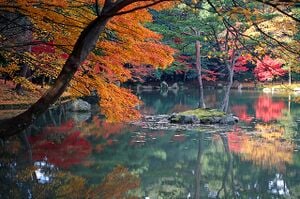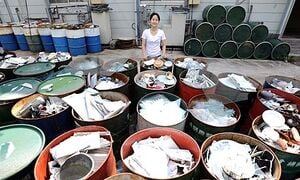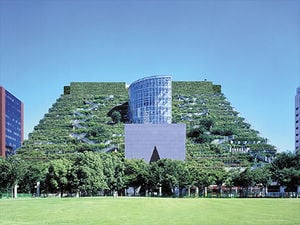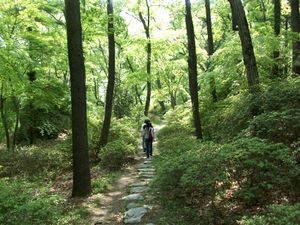
The aim of this page is to recognise, celebrate and encourage the self-empowerment of community agency networks (CANs) and community groups' activism for climate, environment and many other sustainability topics across Japan.
 Revealed: the huge climate impact of the middle classes, theguardian.com (Nov 20, 2023)
Revealed: the huge climate impact of the middle classes, theguardian.com (Nov 20, 2023)  "Moins de biens, plus de liens!" ("Fewer things, more relations!") The Japanese best-selling sensation that promotes a degrowth utopia, The Daily Alternative (Sep 12, 2022)
"Moins de biens, plus de liens!" ("Fewer things, more relations!") The Japanese best-selling sensation that promotes a degrowth utopia, The Daily Alternative (Sep 12, 2022)  Japan swelters in its worst heatwave ever recorded, BBC News (Jun 29, 2022)
Japan swelters in its worst heatwave ever recorded, BBC News (Jun 29, 2022)
Networks and sustainability initiatives[edit | edit source]
- Japan for Sustainability
- Japan, Transition Network
- Konohana Family, Japan, Ecovillage, link updated 11:43, 8 September 2022 (UTC)
Events[edit | edit source]
Regular events: Japan Green Drinks, listings for 5 cities
Community energy[edit | edit source]
Fukushima Community Power Declaration
Renewable energy in Japan
The Fourth Strategic Energy Plan set the renewable share goal to be 24% by 2030. In the next 15 years[timeframe?], Japan intends on investing $700 billion into renewable energy.[56] One initiative the Japanese government has implemented in order to boost the amount of renewable energy produced and purchased in Japan is the feed-in tariff scheme. The scheme encourages companies to invest in renewable energy by providing set prices for various types of renewable energy. The initiatives appear to be working, as renewable energy generation capacity now[when?] stands at 26.2 GW, compared to 20.9 GW in 2012.
On 3 July 2018, Japan's government pledged to increase renewable energy sources, including wind and solar, from 15% to 22–24% by 2030. Nuclear power will provide 20% of the country's energy needs as an emissions-free energy source. This will help Japan meet climate change commitments.
In October 2021 Japan's cabinet approved a new target of 36-38% of renewable share in power generation by 2030. The nuclear target of 20-22% remained unchanged.
In 2022, renewables are estimated to make up 22.7% of Japan's overall electricity generation, including consumption at the site of generation, which is a slight rise from 22.4% in the previous year. W
Reduce, reuse, repair and recycle[edit | edit source]

Japan arguably has the best recycling system in the world. This is due to recent laws passed to encourage its citizens and businesses to actively participate in the recycling. In Japan 50% of all solid waste is recycled, in contrast, the U.S. only recycles 30%.
Kamikatsu is a small town located in the mountains of Tokushima on the island of Shikoku, Japan. In September 2003, the town made a name for itself as a leader in sustainable waste management when it adopted Japan's first "Zero Waste Declaration". The declaration states that Kamikatsu will eliminate its reliance on incinerators and landfills by 2020 to become the first zero-waste community in the region.[1]
Climate action[edit | edit source]
Emission reductions
Out of the global GHG emissions, Japan is responsible for 2.6%. The average rate of CO2 emissions per person in Japan is almost double the global average. Emissions have been slightly reduced since 2013.
Japan has pledged to become carbon neutral by 2050. In 2019 Japan emitted 1212 Mt CO2eq, The per capita CO2 emissions were 9.31 tonnes in 2017 and was the 5th largest producer of carbon emissions. As of 2019 greenhouse gas emissions by Japan are over 2% of the annual world total, partly because coal supplies over 30% of its electricity. Coal-fired power stations were still being constructed in 2021 some may become stranded assets.
Japan's capital Tokyo is preparing to force industry to make big cuts in greenhouse gases, taking the lead in a country struggling to meet its Kyoto Protocol obligations. Tokyo's outspoken governor, Shintaro Ishihara, decided to go it alone and create Japan's first emissions cap system, reducing greenhouse gas emission by a total of 25% by 2020 from the 2000 level.W
Citizens data initiative: Wikipedia:Energy in Japan#Carbon emissions
Ethical consumerism[edit | edit source]
Sustainable transport[edit | edit source]
Transport in Japan is modern and highly developed. Japan's transport sector stands out for its energy efficiency: it uses less energy per person compared to other countries, thanks to a high share of rail transport and low overall travel distances. W
The Shinkansen, or "bullet trains", as they are known colloquially, are the high-speed rail trains that run across Japan. The 2,387 km (1,485 mi) of 8 Shinkansen lines run on completely separate lines from their commuting train counterparts, with a few exceptions. Shinkansen takes up a large portion of the long-distance travel in Japan, with the whole system carrying over 10 billion passengers in its lifetime. W
Urban sustainability[edit | edit source]
- Tokyo DIY Gardening, Hands-on gardening for a crowded city

The ACROS Fukuoka building in Fukuoka City in Japan is an amazing office building with two very distinct sides: one side looks like a conventional office building with glass walls, but on the other side there is a huge terraced roof that merges with a park. The garden terraces, which reach up to about 60 meters above the ground, contain some 35,000 plants representing 76 species. A huge semicircular atrium and the triangular lobby provide contrast to the greenery, in this space is a symphony hall, offices and shops.
The building was constructed on the last remaining green space in the city center, so the architects, Emilio Ambasz & Associates, created a design to preserve the green space as much as possible, while still fitting in a large office building. In addition, a green roof reduces the energy consumption of a building, because it keeps the temperature inside more constant and comfortable. Green roofs also capture rainwater runoff, and support the life of insects and birds.
| Location | Fukuoka City |
|---|---|
| Country | Japan |
| Type | Commercial building |
| Building size | Large |
| Contact | Emilio Ambasz & Associates |
Biodiversity[edit | edit source]
Japan has nine forest ecoregions which reflect the climate and geography of the islands. They range from subtropical moist broadleaf forests in the Ryūkyū and Bonin Islands, to temperate broadleaf and mixed forests in the mild climate regions of the main islands, to temperate coniferous forests in the cold, winter portions of the northern islands. Japan has over 90,000 species of wildlife as of 2019, including the brown bear, the Japanese macaque, the Japanese raccoon dog, the small Japanese field mouse, and the Japanese giant salamander.
A large network of national parks has been established to protect important areas of flora and fauna as well as 52 Ramsar wetland sites. Four sites have been inscribed on the UNESCO World Heritage List for their outstanding natural value. W
Trees, woodland and forest[edit | edit source]

Japan had plenty of trees and forests in the ancient time, but under the control of shoguns and daimyos, Japan became peaceful and flourishing, and they needed more and more woods to build houses, ships and heat in the winter. The available trees would be used up soon, so it was the time to solve the problems that brought on by deforestation. Eventually, Japan succeeded and sustained for a long time. The ancient Japan was a successful example that the big society using top-down[2] approach to solve the environmental problems.
Resources[edit | edit source]
- Just Enough lessons in living green from traditional Japan - Review requested
- Translation of transition materials
Near you[edit | edit source]
About Japan[edit | edit source]
Japan is an island country in East Asia. It is located in the Pacific Ocean off the northeast coast of the Asian mainland, and is bordered on the west by the Sea of Japan and extends from the Sea of Okhotsk in the north to the East China Sea in the south. The Japanese archipelago consists of four major islands—Hokkaido, Honshu, Shikoku, and Kyushu—and thousands of smaller islands, covering 377,975 square kilometres (145,937 sq mi). Japan has a population of nearly 124 million as of 2024, and is the eleventh-most populous country. Its capital and largest city is Tokyo; the Greater Tokyo Area is the largest metropolitan area in the world, with more than 38 million inhabitants as of 2016. Japan is divided into 47 administrative prefectures and eight traditional regions. About three-quarters of the country's terrain is mountainous and heavily forested, concentrating its agriculture and highly urbanized population along its eastern coastal plains. The country sits on the Pacific Ring of Fire, making its islands prone to destructive earthquakes and tsunamis.
The first known habitation of the archipelago dates to the Upper Paleolithic, with the beginning Japanese Paleolithic dating to c. 36,000 BC. Between the fourth and sixth centuries, its kingdoms were united under an emperor in Nara, and later Heian-kyō. From the 12th century, actual power was held by military dictators (shōgun) and feudal lords (daimyō), and enforced by warrior nobility (samurai). After rule by the Kamakura and Ashikaga shogunates and a century of warring states, Japan was unified in 1600 by the Tokugawa shogunate, which implemented an isolationist foreign policy. In 1853, a United States fleet forced Japan to open trade to the West, which led to the end of the shogunate and the restoration of imperial power in 1868. In the Meiji period, the Empire of Japan pursued rapid industrialization and modernization, as well as militarism and overseas colonization. In 1937, Japan invaded China, and in 1941 attacked the United States and European colonial powers, entering World War II as an Axis power. After suffering defeat in the Pacific War and two atomic bombings, Japan surrendered in 1945 and came under Allied occupation. After the war, the country underwent rapid economic growth, although its economy has stagnated since 1990.
External links



